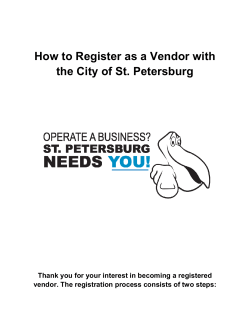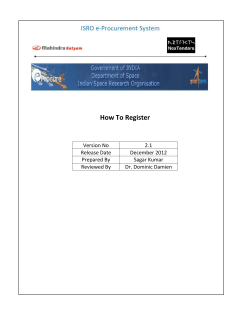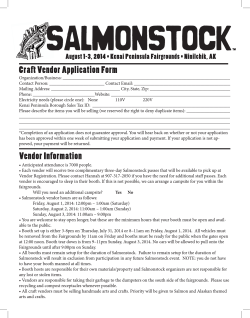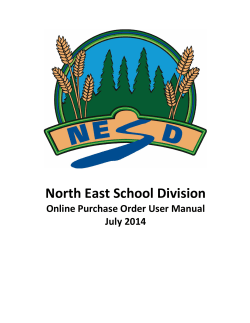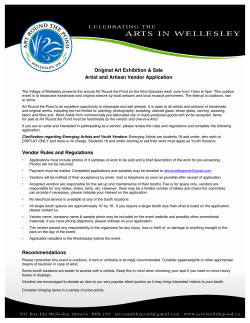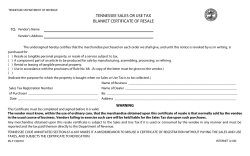
How to Construct A Lube Supply Agreement
How to Construct A Lube Supply Agreement Mike Johnson, Principal Consultant, AMRRI Dan Moss, Maintenance Manager, Bowater Paper Corporation Note: This paper was originally published for presentation at Lubrication Excellence ‘03 Abstract: Establishing corporate contracts to purchase materials, particularly lubricants, holds a bittersweet appeal to many. Mill personnel work closely with their vendors, in some cases for a prolonged period, to establish business relationships deliver results when the chips are down. While it makes good sense to bundle purchases together in order to leverage increased volume into improved pricing, improved delivery and the hope of improved service, the reality for many is that corporate purchase agreements do not deliver. However, sometimes they do deliver. Come take a look at one approach that has worked well. Introduction: Broadly speaking, a key objective for any organization, according to business owners, is to return value to the shareholder. Value can be spelled in a multitude of ways. Ultimately, there needs to be a financial return for the owner if the company wishes to keep the owner’s investment. It doesn’t matter if the company is public or private, company owners wish to have the capital invested in a company respected and put to the best use. Manufacturers create value by using the owners invested capital to buy machines, processes and ideas, and by using these assets to convert raw materials to finished goods. There are many subcomponents within the organization that influence the ability to make these materials conversion, not the least of which is maintenance. The way that maintenance managers can contribute most effectively to the conversion process is by assuring that the machines are always ready to operate, and always operate with repeatability, when it is time to produce. There are a handful of factors that are recognized as major influencers on equipment mechanical reliability, including alignment, balance, lubrication, and contamination control. For our purposes, we will focus on how the organization can purchase maximum usefulness and effectiveness (ie. purchase maximum value) from available vendors to meet equipment lubrication requirements. While this may seem unnecessary to state, maintenance and purchasing management need to understand that the central benefit of a sourcing exercise is the opportunity to gain better effectiveness per dollar spent rather than spending fewer dollars per unit purchased. With an appropriate focus, lubricant sourcing for multiple plants can add value to the corporation. This paper will explore the requirements for creating value in lubricant sourcing contracts. Corporate Contracts, A Cost Savings Initiative The drive to reduce costs can be short-circuited by a “low bid” mentality if a sound, objective plan is not developed to identify, quantify and evaluate the other essential elements of a supplier’s offerings. In lieu of objective data to weigh against a low dollar bid, the low bid will always be the choice of purchasing personnel challenged with the task of getting the most products for the company dollar. When a company clarifies its objective from getting the lowest cost to obtaining the best value and then develops a process to evaluate other factors such as product quality and service offerings, then both reduced cost and enhanced products are possible. One paper producer employed such a process in the mid 1990’s with excellent results and here’s how it worked. The company began with a corporate initiative to review the purchasing needs at its four large paper mills to identify goods and services that may be served through corporate contracts at a savings to the company. One of the early candidates was lubrication products. Within the four mills, three different suppliers were primary, with products actually purchased from 7 or 8 different suppliers. The direct annual costs were close to $2 million. At each location there was a fairly strong relationship between the mill maintenance personnel and their suppliers built through years of working together to solve maintenance issues. An approach that took into account the needs and expectations of the maintenance professionals at each site was required. There are several steps in the process. Those that will be addressed below are as follows: Steps in the process: 1. Team formation 2. Setting Objectives and collecting information. 3. Quantitative Measurement. 4. Contract negotiation. 5. Implementation. Team Formation With the idea of value creation setting squarely at the foundation of the exercise, the first step in the process is to assemble a team and begin to form objectives, timetables and methods to measure the inputs. For lubricant sourcing in a multiple facility environment where there is a significant machine reliability penalty for poor quality, it makes sense to construct a multi-functional and multifacility team. ‘Multi-functional’ suggests a need for team members with specific knowledge of a business function. Since Maintenance (Reliability), Production, and Purchasing department objectives may suffer when lubricant sourcing activities sour, it would seem appropriate to include representatives from each of these departments on the team. Whether to select individuals from each department at each physical location for participation would be subject to distance, cost, and time limitations for the organization. However, there should be sufficient representation from each facility that will be expected to implement the decision. Additionally, the participating representative should be capable of speaking on behalf of the needs for the facility. For a small corporation these guidelines are useful. For a large organization with many physical sites these guidelines would obviously create a work team that is too big to work efficiently. Work teams loose efficiency with increasing size as work team members loose the personal stake in the quality and timeliness of their work tasks. Team size needs to be large enough to represent the vested interests but small enough to maintain an efficient and effective workflow. Corporate Buy Team While the lubrication Corporate Contract was not the first corporate contract the company entered using a multi-facility team, it was the first to make extensive use of non- purchasing personnel to define the parameters and participate throughout the evaluation process. The team consisted of a corporate sponsor, three mill purchasing agents, and three mill maintenance / engineering personnel. The team identified three general areas for evaluation – pricing, product quality, and service offerings. They then set a six-month schedule to pull together the data for final evaluation. Setting a timeline: There are a few approaches to setting a timeline. Considerations must be given for the following items, with an example of a timeline: 1. Identifying key criteria Initial meeting. 2. Developing metrics Initial and second meeting. 3. Collecting inputs from vendors Third meeting. 4. Verifying those inputs Third and fourth meeting. 5. Applying the metrics to the inputs for the quantitative Fourth meeting. evaluation. 6. Selecting a vendor Final meeting. 7. Implementing the conversion at each facility involved in the Site meetings. process. Some of these activities can, and probably should, be handled by telephone/teleconference interaction and or mail/email. Team formation, vendor presentations, quantitative rating and decision-making activities occur more effectively when clear communication opportunity exists between parties. Logistics of Team Activity The initial kick off of the Lube Corporate Buy Team was a commissioning at the corporate headquarters. The team members met each other, initial objectives were defined, and the estimated timeframe was set. The commercial and technical leaders were selected. Even though the four plants are geographically removed from each other, it was an important part of the process that the team members got to know each other and form a team. A significant amount of work followed this initial meeting and the team was able to effectively communicate by phone or e-mail up to the final team meeting. In this case the team actually met as a whole on only two occasions – the initial kick off and the final evaluation meeting, yet the effectiveness remained very high. Setting Objectives and Collecting Information. It is beneficial to have the overt blessing and support of the company’s most senior leadership before embarking on a project that requires change in multiple business units. Project objectives should also be consistent with broad business strategies. Tacit support of project objectives by senior management will markedly increase the likelihood that business units will carry through changes that, incrementally, could seem counter productive or even costly. Though it is not the project team’s responsibility to draw out those broader organizational strategies, it is certainly wise to repeatedly check to verify that the project objectives fall in line with perception of corporate strategic direction. Objectives could be categorized as competing or complimentary. An example of complementary objectives would be those objectives that benefit all facilities equally, such as a net reduction in cost of, or a net increase in the quality of, the sourced materials. Competing objectives, of course, would be objectives that benefit facilities but not equally, or perhaps even hinder some facilities but provide a net gain for the organization at large. Delivery efficiency or standardization of required plant services could fall into this category. It is inevitable that establishing objectives will require give-and-take for all parties involved in the project. If the original starting position is particularly diverse it is likely that implementation could require significant give-and-take, with a gentle but constant push from top management. For example, if senior management appears to be overtly supporting a move by the company toward ISO 14000 certification, and the same management intends to eventually purchase from suppliers with ISO 14000 credentials, then a long term contract with a vendor that is not considering certification may not be advisable. There are many seemingly useful objectives that could be considered, such as: i. Reduce the number of vendors ii. Reduce the number of discrete purchase orders iii. Improve pricing through consolidation iv. Improve access to service through consolidation v. Improve quality of products purchased. vi. Improve delivery commitment. After defining a set of objectives it is useful to rate them in order of significance. For instance, if improved quality and reduced cost of materials are each deal breakers, then these prioritizes must receive weighting accordingly. Goals and Priorities It was the stated goal of this team to identify the “best value” for the company and base the corporate purchase decision upon a qualitative measure of that value. In many cases the only qualitative analysis that is made is the initial product pricing. Other aspects of the decisionmaking process are usually based upon subjective information and very little hard data. The team committed itself to providing hard data that could be evaluated in a qualitative manner so that the final decision would be based upon facts rather than feelings. In addition, the team wanted to be in a position to support a recommendation to go with the best value provider even if they were not the low cost supplier. The specific goals of the team were both commercial and technical. Some of the commercial goals were to reduce the number of vendors, reduce the number of discrete purchase orders, and improve the pricing through consolidation. Some of the technical goals were to improve access to service through consolidation, improve the quality of products purchased, and improve delivery commitments. With these broad goals identified the team was ready to dig into the details to determine which lube supplier could best satisfy these requirements. A purchasing agent was selected to pull together the commercial considerations and one of the technical persons was given the leadership role in investigating the technical questions. Evaluation on Three Fronts: Product Quality, Services and Pricing. The first activity undertaken by the team after the areas for evaluation were identified was the development of a product quality evaluation process. The evaluation of product quality is the primary component that sets this corporate purchase agreement apart from most similar agreements. The process followed several steps beginning with a review of products used and ending with a qualitative comparison of each of the three suppliers based upon the quality of four key products. This process is further described in Appendix A. On the commercial side, each site reviewed the standing contracts with their existing suppliers. After reviewing all the potential suppliers it was decided that the three primary suppliers to the four mills were respected companies capable of supplying all four mills and therefore the field of potential vendors was limited to those three. A composite product listing from the four mills was pulled together with usage data for the three previous years. This was then provided to each of the suppliers for bids. Concurrent with the development of the pricing structure, a comprehensive list of service offerings was being developed by the corporate buy team. Each facility identified services perceived to be value-added and necessary. In addition the suppliers identified additional service offerings that they were willing to provide. For the final analysis a complete service offerings matrix was built and the three suppliers were compared to each other. Developing criteria evaluation metrics. Quantitative scoring methods enable a team to express vendor inputs in quantifiable statements that measure the degree to which products and services actually meet team and organizational requirements. By jointly developing the scoring methodology prior to collecting vendor inputs, it is possible to eliminate significant emotional entanglements down stream of the decision. There are a number of ways to approach scoring project criteria. Assuming all criteria can be reduced to a statement and prioritized, the method for scoring the criteria should be rigorous enough to justify the decision as rational and balanced, but be simple enough that team members can understand and fully support the approach. Vendor Evaluation. The team determined that the vendor would each be rationally, quantitatively evaluated for Product Quality, Services and Pricing. The weighting of importance for each area was: Product Quality Services Pricing 40% 30% 30%. The team devised an approach to quantify performance for each of the three criteria. After each criterion were clearly defined, measured and given a score the mill would factor each criteria by multiplying the criteria score by the weighting for that criteria. Product Quality Evaluation Product Quality represented 40% of each vendor’s total score. There were many products currently in use between the 4 mills involved in the project. Since it was impractical to test each product for each vendor, the team decided to select the products that were of particularly high importance to the mills and limit the product quality analysis to these key items. The team selected the four primary products that comprised the majority of product consumption by volume, which accounted for about 85% of the annual lubricant / hydraulic oil usage across the company. The product quality score would be based upon how well each supplier’s key products performed in the testing. A third party was selected to handle all of the details of the testing. Great strides were taken to make the product quality testing totally anonymous and unbiased. The products selected, and the significance ratings for each product were: 1. ISO 220 Paper Machine Oil 2. ISO 46 Premium Hydraulic oil 3. General Purpose NLGI grade 1 grease 4. Premium Synthetic grease (suitable for paper machine wet ends). .4 .2 .2 .2 A final crosscheck was made of the products with the suppliers to be sure that they were comparable products. The identification of the twelve products (3 suppliers, 4 products each) was given to the third party who then secured the products for testing. The list of product quality tests to be conducted was developed jointly by the technical champion and the third party. The tests included standard product tests as well as non-standard tests that emphasized particular product qualities desired in the mill environment. Prior to receiving the results of the product testing the Corporate buy team and the third party reviewed the list of product tests performed for each product and gave each test a weight, a number from 1 – 10, based upon two factors. 1. How important is that particular trait to the mill, and, 2. How closely does the described lab test replicate the actual mill environment? A ten meant that the trait was critically important to the mill and the laboratory test was an excellent representation of the field environment the product would be exposed to. Following this, the actual laboratory results were then given a rating. Again a 0 – 10 scale was used. Prior to viewing the test data the team identified what would be an excellent test result and gave that a score of ten and then made a graduated scale down to what would be considered a “poor” rating and gave that a one. With this scale developed it was now possible to assign ratings to the actual lab results for each product. (Shown in Appendix 1) The mathematical expression of the rating method is: PQ = (Β ∗ Τ ∗ Α), where PQ = Vendor Product Quality Score for each of 4 products. B = Mill rating of significance of the property to the mill on a T = Mill rating of the relevance of the test to measure the lubricant property A = Score of the actual lubricant test result against the quality expectation. T h e p r o c e Product Circulation Oil Paper Machine GP Grease Synthetic Grease Sum of Score Vendor A Vendor B Vendor C 0.135 0.313 0.126 0.111 0.685 0.15 0.311 0.139 0.182 0.782 0.148 0.308 0.168 0.093 0.717 Table 1. Vendor Product Quality Aggregate Score. Vendor rating at this point became a simple mathematical calculation derived by multiplying the weight for each test by the rating each product received from the independent testing. Since each product had several tests performed a summation gave a final product quality score. The product quality score was reduced to a 0-1 scale, with 1 representing a high score, as shown in Table 1. The product quality score was multiplied by the category weight (40%) to arrive at the final product score fore each vendor as shown in Table 3. Services Evaluation Services scores represented 30% of each vendor’s total score. The team wanted to evaluate the services that each vendor offered. Since each vendor had provided differing levels of service to each of the three mills, and since there is/was no single standard against which a ‘quality’ service delivery could be measured, the mills were forced to adopt a more subjective approach. The first step was to define the specific criteria that would be evaluated for the service score. Consideration was given, and specifics were defined, for each of the following: 1. Identification of the services that were required by all mills. 2. Identification of the services that were offered by all vendors. 3. Identification of the services that were not offered uniformly by all vendors, but that was considered useful or necessary by at least one of the participating mills. After identifying the list of services to consider, the team set a perfect score of 30 if a vendor provided all of the services listed in an excellent manner. Through our discussions we came to an understanding that while each mill was getting some portion of the services listed, none of us was receiving service at this “ideal” level. We estimated that the vendors covered roughly a 20point range, which fit well within the 30-point baseline. The team members then evaluated each of the pre-defined items as noted in Figure 2. If a team member had experience, and the experience was positive, then a value of ‘+1’ would be given to the vendor for that particular service offering. If the member had received a negative service experience from the vendor then a value of ‘–1’ was given to the vendor for that particular service offering. If the mill member had no experience with the identified service item then the member refrained from scoring the vendor. The evaluation then became a comparison of each supplier’s stated service offerings combined with each mill’s experience. For example, one supplier offered up to 1,000 free lube tests. In this case one of the mills had benefited from this service for three years. The second supplier had not offered this service but was willing to provide “some” free lube testing. The third supplier would coordinate the testing but would pass on the cost to us. Therefore we looked favorably upon the offering of the first supplier and increased their service offering score by 1 from the baseline. The second supplier’s response, while slightly positive, was not sufficient to warrant an increase from the baseline. The third supplier’s response was definitely deficient compared to the other two therefore the service rating was decreased by 1. Vendor A Vendor B Vendor C Troubleshooting Baseline Free Technical Support for lube related issues. Partner in problem solving Full-fledged lube analysis lab free of charge. Dedicated lube engineer servicing our accounts Paper mill specific expertise readily available. 30 1 0 -1 -1 0 30 1 1 -1 0 1 30 1 1 0 -1 -1 -1 0 -1 -1 0 0 -1 0 -1 1 -1 0 -1 -1 0 0 -1 -1 -1 0 -1 0 0 1 -1 0 -1 0 0 -1 0 0 1 -1 0 0 1 -1 -1 -1 0 1 -1 0 0 Post Use Lube Support Provide assistance in the Waste Oil / Fuel Program. Recycling support. Leak / Waste reduction program. Inventory Control Supplier monitor and control mill inventories at proper level. Local inventory, quick response on orders. Mini-bulk support. Help in minimizing bulk drums. Other Services Routine visits, weekly / monthly. Regular sampling and testing of lube systems. Lube software program - free of charge. Provide lube technical training to our people periodically. Twenty four hour support availability Range of products / specialty products Prompt return of calls and inquiries. Cost reduction guarantees. Lube survey to verify proper application, consolidation, etc. Vendor Scores. Vendor A Vendor B Vendor C 24 28 24 Figure 2. List and rating of services either offered, required or desired. With this approach the members believed that the quality of the service could be rated without ambiguity, and without penalizing any vendor for failing to have a previous business experience with any given mill. Pricing Evaluation Product pricing represented 30% of each vendor’s score. Each vendor was provided with a ‘best guess’ of expected product consumption based on historical consumption levels. The vendors were asked to price the products they would be recommending for replacement of the currently used products at mill historical volume. This number served as the baseline going into price negotiations. During pricing evaluations all price/volume/delivery point variations were eliminated leading final presentations. Two of the three vendors brought additional concessions to the table at the time of presentation, and those concessions were converted to a pure dollar value. The team calculated the total product cost for each vendor, including last minute concessions. The least cost (lowest total cost) vendor was given a score of 1. The other price scores were given a percentage score representing how far they were from being the low cost bidder. The mathematical expression for price rating is: S-PVn = 1 / (Vn / LCB ), where: S-PVn = Pricing Score for Vendor n Vn = Vendor A, B, C LBC = Low Cost Bidder. The price score was multiplied by the weighting value of 30 to produce a weight adjusted price rating. Compiling the Scores The final step was to combine the scores, weigh the scores as agreed and determine which vendor received the highest score. Table 3 shows the combined scores, the weighting for each score and the total score for each vendor. Product Quality Service Quality Pricing Vendor A Vendor B Vendor C Weighting Base Weighted Base Weighted Base Weighted 40% 0.685 27.4 0.782 31.28 0.717 28.68 30% 30 24 30 26 30 24 30% .81 24.3 1 30 .99 29.7 Total Weighted Score 75.7 87.28 82.38 Table 3. Final scores and weighted scores for vendor selection. The vendor with the highest score was selected to become the supplier to each of the 4 mills. Summary The implementation process began soon after the final selection. The supplier had a lot invested in making the transition since they were gaining two large facilities with significant new sales volume. At the same time the company was anxious to realize the results of the improved product quality, the service enhancements, and the price reductions. Within three months lube surveys had been conducted at the mills migrating to the new supplier. Product transitions and consolidations were made. Within approximately six months the company was converted to a single supplier providing over 94% of the lubricants and hydraulic oils for the entire company. During the first year the direct product savings to the company was in excess of 20%. In addition numerous lubrication-related improvements were made at each site through the cooperative team effort of the new supplier and mill forces. While the effort required a significant amount of extra effort on the part of the team members, the end results were extremely positive for the company and gratifying to the team. In the final analysis, having a good plan and executing that plan in a team environment proved to be the right formula for success. Appendix A. Product Quality Rating Matrix. Test Rating by Significance Product Type 1 - Circulating Oil Comparison ASTM D445 M1 M2 M3 M4 Avg. Sig. ASTM D2270 ASTM D4172 Viscosity @ 40 Viscosity @ 100 Viscosity Index 4 Ball Wear Rating 3 7 7 8 3 9 9 8 0 7 9 6 3 4 6 7 2.3 6.8 7.8 7.3 ASTM D2783 Load wear Rating 8 9 4 5 6.5 ASTM D1401 ASTM D4742 ASTM D665 B ASTM D189 Demulsibility Oxidation Resistance Rust Prevention Carbon Residue 9 8 8 8 9 9 9 7 7 8 6 6 9 6 5 4 8.5 7.8 7.0 6.3 FTM-3009 Cleanliness 3 3 5 Product Type 2 - Hydraulic Oil Comparison ASTM D445 M1 M2 M3 3.7 M4 Avg. Sig. ASTM D2270 Viscosity @ 40 Viscosity @ 100 Viscosity Index 3 7 5 3 8 7 0 7 9 4 3 6 2.5 6.3 6.8 ASTM D4172 ASTM D1401 ASTM D4742 ASTM D665 B ASTM D189 FTM-3009 4 Ball Wear Rating Demulsibility Oxidation Resistance Rust Prevention Carbon Residue Cleanliness 9 8 8 9 3 3 9 9 8 9 7 3 7 9 7 5 6 5 9 6 8 4 7 5 8.5 8.0 7.8 6.8 5.8 4.0 8 8 8.0 Cin Mil Thermal Stability Product Type 3 - GP Grease Comparison M1 M2 M3 M4 Avg. Sig. FTM 313 ASTM D2509 ASTM D1264 DIN 51802 Worked Penetration Timken Load Rating Water Wash Resistance Emcor Rust Resistance 5 5 8 8 7 7 8 8 4 7 8 6 5 2 1.5 3 5.3 5.3 6.4 6.3 ASTM D4425 Centrifugal Stability 9 9 5 4 6.8 ASTM D2266 Four Ball Wear Test 8 8 9 1 6.5 Product Type 4 - Fourdriner Grease Comparison M1 M2 M3 M4 Avg. Sig. FTM 313 ASTM D2509 ASTM D1264 DIN 51802 ASTM D4425 Worked Penetration Timken Load Rating Water Wash Resistance Emcor Rust Resistance Centrifugal Stability 5 5 8 8 9 7 7 8 8 9 4 5 6 9 8 6 5 4 1 2 5.5 5.5 6.5 6.5 7.0 ASTM D2266 Four Ball Wear Test 8 8 9 3 7.0
© Copyright 2025
